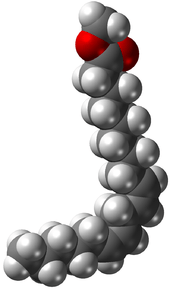Fatty acid ester

Fatty acid esters (FAEs) are a type of ester that result from the combination of a fatty acid with an alcohol. When the alcohol component is glycerol, the fatty acid esters produced can be monoglycerides, diglycerides, or triglycerides. Dietary fats are chemically triglycerides.
Glycerol Esters of Fatty Acids occur as colorless to brown powders, flakes, coarse powders, or granular or waxy lumps, or are a colorless to brown semi-fluids or liquids. They are odorless or have a characteristic odor.[1]
Biodiesels are typically fatty acid esters produced by the transesterification of vegetable fats and oils which results in the replacement of the glycerol component with a different alcohol.
Fatty Acid Methyl Esters (FAME) are esters of fatty acids. The physical characteristics of fatty acid esters are closer to those of fossil diesel fuels than pure vegetable oils, but properties depend on the type of vegetable oil. A mixture of different fatty acid methyl esters is commonly referred to as biodiesel, which is a renewable alternative fuel. FAME has physical properties similar to those of conventional diesel. It is also non-toxic and biodegradable.[2]